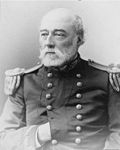| Name | Picture | Rank | Assigned
(Orders) | Assumed
(On Station) | Relieved
(Orders) | Relieved
(On Station) | Flagship(s) |
|---|
| RADM Louis M. Goldsborough |  |  | February 1865 | 18 July 1865 [5] | 1867 | 14 July 1867 [5] | Colorado [6] |
| ADM David G. Farragut |  |  | ? | 14 July 1867 [5] | ? | 10 November 1868 [5] | Franklin [7] |
| CDRE Alexander M. Pennock | |  | ? | 10 November 1868 [5] | ? | 28 February 1869 [5] | Ticonderoga [8] |
| RADM William Radford [9] |  |  | ? | 1869 [9] | ? | 1 March 1870 [9] | Franklin [7] |
| RADM Oliver S. Glisson [8] |  |  | ? | August 1870 [8] | ? | January 1871 [8] | Franklin [8] |
| RADM Charles S. Boggs [8] |  |  | ? | January 1871 [8] | ? | 1 January 1872 | Franklin
Plymouth
Brooklyn [8] |
| RADM James Alden Jr. |  |  | ? | 1 January 1872 [10] | ? | 2 June 1873 [10] | Wabash [11]
Brooklyn [8] |
| RADM Augustus Case | |  | ? | 1873 [12] | ? | 1875 [12] | Franklin
Wabash [8] |
| RADM John L. Worden |  |  | ? | 1875 [13] | ? | 5 October 1877 [8] | Franklin
Marion
Trenton [8] |
| RADM William E. Le Roy [8] |  |  | ? | 5 October 1877 [8] | ? | 23 January 1879 | Trenton [8] |
CAPT John Lee Davis
(pro tem) [8] | |  | ? | 23 January 1879 [8] | ? | February 1879 | Trenton [8] |
| RADM John C. Howell [14] |  |  | 1878 | February 1879 [8] | ? | 16 September 1881 | Trenton
Quinnebaug
Wyoming [8] |
| RADM James W. Nicholson | |  | ? | 16 September 1881 [15] | February 1883 [15] | 10 March 1883 | Lancaster [8] |
| RADM Charles H. Baldwin | |  | ? | 10 March 1883 [16] | ? | September 1884 | Lancaster [8] |
| RADM Earl English | |  | ? | September 1884 [8] | ? | May/June 1885 | Lancaster [8] |
| RADM Samuel Rhoads Franklin | |  | ? | May/June 1885 [8] | 20 July 1887 [17] | 24 August 1887 [18] | Pensacola [8] |
| RADM James A. Greer |  |  | ? | 1887 [19] | ? | 1889 [19] | ? |
| Unknown? | | ? | ? | 1889 | ? | 1893 | ? |
| RADM Henry Erben |  |  | June 1893 [20] | ? | August 1894 [20] | ? | Chicago [21] |
| RADM William A. Kirkland [22] | |  | April 1894 [20] | | November 1895 [20] | | San Francisco [23] |
| RADM Thomas O. Selfridge Jr. [24] |  |  | November 1895 [20] | | February 1898 [20] | | Minneapolis [25] |
| RADM John Adams Howell | |  | January 1898 [20] | | April 1898 [20] | | ? |
| The European Squadron returned to U.S. waters at the start of the Spanish–American War in April 1898, and did not return until July 1901. |
| RADM Bartlett J. Cromwell | |  | ? | July 1901 | 9 February 1902 [26] | 9 February 1902 [27] | Chicago [28] |
CAPT Joseph E. Craig
(Senior Officer Present) [29] | |  | ? | 9 February 1902 | ? | April 1902 | ? |
| RADM Arent S. Crowninshield |  |  | March 1902 [26] | 30 April 1902 [30] | 3 March 1903 [31] | 20 March 1903 [32] | Illinois [33] |
CAPT James Henry Dayton
(Senior Officer Present) [32] | |  | ? | 20 March 1903 | ? | 28 April 1903 | ? |
| RADM Charles S. Cotton |  |  | ? | 28 April 1903 [32] | ? | 16 February 1904 | Kearsarge
(June–July 1903) [34]
Brooklyn [35] |
CAPT Harry Knox
(Senior Officer Present) [36] |  |  | ? | 16 February 1904 | ? | 28 March 1904 | Brooklyn |
| RADM Joseph Coghlan |  |  | ? | ? | ? | 20 April 1904 [36] | ? |
| RADM Theodore Frelinghuysen Jewell |  |  | ? | 20 April 1904 [36] | ? | ? | Olympia |
| In 1905 the European Squadron was absorbed into the North Atlantic Fleet. |


















